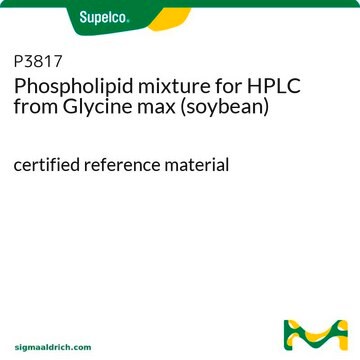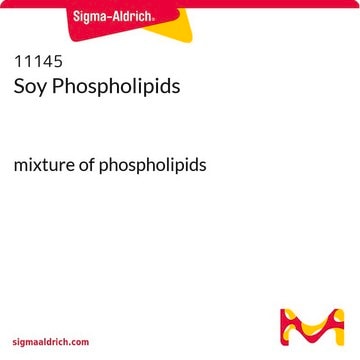If this product has an expiration or retest date, it will be shown on the Certificate of Analysis (COA, CofA). If there is no retest or expiration date listed on the product's COA, we do not have suitable stability data to determine a shelf life. For these products, the only date on the COA will be the release date; a retest, expiration, or use-by-date will not be displayed.
For all products, we recommend handling per defined conditions as printed in our product literature and website product descriptions. We recommend that products should be routinely inspected by customers to ensure they perform as expected.
For products without retest or expiration dates, our standard warranty of 1 year from the date of shipment is applicable.
For more information, please refer to the Product Dating Information document: https://www.sigmaaldrich.com/deepweb/assets/sigmaaldrich/marketing/global/documents/449/386/product-dating-information-mk.pdf
推荐产品
用途
sufficient for 100 colorimetric or fluorometric tests
应用
cosmetics
food and beverages
pharmaceutical
检测方法
colorimetric
fluorometric
运输
dry ice
储存温度
−20°C
一般描述
在该检测中,磷脂(如卵磷脂、溶血卵磷脂和鞘磷脂)会被酶促水解为胆碱,随后使用胆碱氧化酶和H2O2特异性染料进行测定。反应会产生比色(570 nm)/荧光(λex = 530/λem = 585 nm)产物,此产物与样品中的磷脂浓度成正比。比色法的线性检测范围是3 - 200 μM,荧光法则为0.6 - 20 μM。
特点和优势
适用性
原理
警示用语:
Danger
危险声明
危险分类
Aquatic Chronic 3 - Resp. Sens. 1
储存分类代码
10 - Combustible liquids
历史批次信息供参考:
分析证书(COA)
其他客户在看
-
How can I determine the shelf life / expiration / retest date of this product?
1 answer-
Helpful?
-
-
How is shipping temperature determined? And how is it related to the product storage temperature?
1 answer-
Products may be shipped at a different temperature than the recommended long-term storage temperature. If the product quality is sensitive to short-term exposure to conditions other than the recommended long-term storage, it will be shipped on wet or dry-ice. If the product quality is NOT affected by short-term exposure to conditions other than the recommended long-term storage, it will be shipped at ambient temperature. As shipping routes are configured for minimum transit times, shipping at ambient temperature helps control shipping costs for our customers. For more information, please refer to the Storage and Transport Conditions document: https://www.sigmaaldrich.com/deepweb/assets/sigmaaldrich/marketing/global/documents/316/622/storage-transport-conditions-mk.pdf
Helpful?
-
-
Is the 10 ml of Assay Buffer in MAK122 sufficient for 100 assays? Also, what amount of sample/buffer should be used?
1 answer-
1. The general recommendation for homogenization is a 1:10 solid to buffer ratio, for example, 20mg solid with 200 uL of Buffer. However, this ratio may not always be optimal. If there are concerns about having enough assay buffer for both homogenization and assays, the homogenization can be run with a different homogenization buffer, provided that it contains at least 0.5% Triton X-100. Please note that the amount of Assay Buffer needed per sample should be enough to yield 40 microliters of supernatant, unless you choose to use your own homogenization buffer with 0.5% Triton X-100.
2. The kit is usually tested on tissue samples. However, it has not been tested on tissues themselves.
3. For homogenizing samples, they can be run through 10-20 passes in a Dounce homogenizer on ice or by sonication, preferably performed in an ice-water bath. The degree of tissue lysis can be checked under a microscope. After homogenization, it is recommended to centrifuge the homogenate at 14,000 g for 10 minutes.
Helpful?
-
-
Why is cold assay buffer listed as a potential cause for the assay not working correctly? Can a 37 or 25 degree water bath be used to thaw the assay buffer? Can the assay buffer be stored at room temperature instead of at -20 degrees?
1 answer-
The troubleshooting bulletin for MAK122 suggests that if the assay does not work, it could be due to the assay buffer not being at room temperature. This is because the enzyme is more active at room temperature than in colder conditions. Although stability data for the assay buffer at room temperature is not available, it is recommended to store it at -20 degrees or evaluate the suitability of room temperature storage. While the composition of the assay buffer is proprietary, it is expected to be stable at room temperature. Additionally, a 37 or 25 degree C water bath can be used to thaw the assay buffer, with a caution against excessive heating and a recommendation to remove it from the water bath once it reaches room temperature.
Helpful?
-
-
To prepare the 0.5% Triton X-100 solution to dilute my samples, should I dilute Triton x-100 in water, in the assay buffer, or something else?
1 answer-
The 0.5% Triton X-100 solution to be used as the sample diluent may be prepared using water.
Helpful?
-
Active Filters
我们的科学家团队拥有各种研究领域经验,包括生命科学、材料科学、化学合成、色谱、分析及许多其他领域.
联系客户支持






